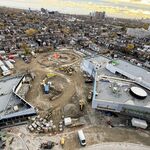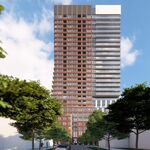ShonTron
Moderator
Member Bio
- Joined
- Apr 24, 2007
- Messages
- 12,544
- Reaction score
- 9,546
- Location
- Ward 13 - Toronto Centre
Whether you reduce the sidewalk, that space is already being taken up by people waiting for the streetcar, thus not actually available for pedestrians to use.
That is a good point. One place that is really bad is the westbound stop for the 505 Dundas at University as it can be very congested as it's narrow between the building and the curb. Thankfully, the proposed 481 University redevelopment does address this.
Maybe they won't fit, I was talking about single islands not double islands like we see on Spadina, and I was thinking of putting them at intersections as opposed to mid-block sections, but ultimately there's only enough space in the ROW to be shared amongst, cars, transit and pedestrians, as well as cyclists.
The trouble is that the single islands won't fit wheelchairs and other wheeled devices when the ramps are deployed on the new streetcars. Even the wide Spadina and St. Clair ROW islands had to be rebuilt to accomodate them. Recently, some islands were simply removed as there was no room to expand them.




